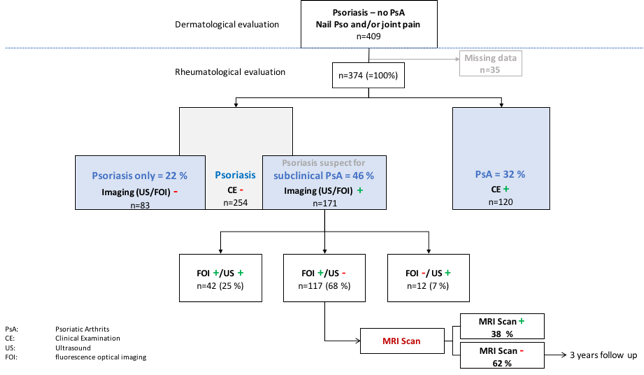Session Information
Date: Wednesday, November 8, 2017
Title: Spondyloarthropathies and Psoriatic Arthritis – Clinical Aspects and Treatment V
Session Type: ACR Concurrent Abstract Session
Session Time: 11:00AM-12:30PM
Background/Purpose: Psoriasis (Pso) is one of the most common chronic inflammatory skin diseases in Europe. Psoriatic arthritis (PsA) is closely associated to Pso whereas the skin manifestation appears usually years before PsA-related symptoms emerge. Biomarkers for its early detection are missing In early PsA manifestations, changes in synovial vascularisation combined with increased expression of proangiogenic factors appear first. Therefore, imaging biomarkers for detection of changes in vascularisation can be useful for early detection of joint disease. Fluorescence-optical imaging (FOI) is a new method to detect changes in microvascularisation of the hands and might be of value in early detection of (subclinical) signs of inflammation in Psoriasis patients
Methods: 411 patients with dermatologically confirmed Pso were included without diagnosis of PsA but risk factors for its development (nail psoriasis and/or joint pain or swelling within the last 6 months). Clinical examination (CE; swollen (66) and tender (68) joint count, enthesitis, dactylitis assessment) and standardised ultrasound (US) assessment was performed by a qualified rheumatologist to assess PsA symptoms. Additionally, FOI was performed. Data was analysed for an increased vascularisation of musculoskeletal structures of hands as marker of inflammation. In cases of discrepant results (positive FOI and negative results for CE and US), MRI was performed to validate the FOI-surrogate indicator of inflammation. Patients with negative MRI results are followed up over a 24-month period (XTEND) to evaluate rate of PsA-development.
Results: 45.5% of the Pso patients (mean age 55.8 years, 57% female, baseline BSA 6.6%, mean duration of Pso 19.1 years) were diagnosed positive for PsA by rheumatologists either by CE (32%) or US. In a total 73.3% of the patients an increase of fluorescence signal intensities of the hands was detectable by FOI (figure 1). In 22% of the patients neither in CE and US nor in FOI any signs of musculoskeletal inflammation could be detected. In 38% of the patients suspected inflammation by FOI was confirmed by MRI scan. 13.1% of the patients were identified for follow-up measurement in XTEND.
Conclusion: In this cohort of patients with active Pso and not yet diagnosed PsA, more than 40% of the patients were classified as PsA by CE and US only. Additionally, in another 28.7% signs of inflammation were detected by FOI technique while MRI scan was only positive in 38 % of these patients. FOI might have the potential for early detection of musculoskeletal involvement in patients with Pso. Its possible high sensitivity in the detection of inflammation will be further evaluated: patients with positive FOI and negative MRI will be repetitively re-evaluated for a 24-month follow-up period to evaluate the predictive value of positive FOI in development of (clinical) active PsA.
To cite this abstract in AMA style:
Koehm M, Rossmanith T, Langer HE, Backhaus M, Burmester GR, Wassenberg S, Köhler B, Burkhardt H, Behrens F. Detection of Clinical Signs of Arthritis and Subclinical Evidence of Inflammation in Psoriasis Patients with Risk for Arthritis: Value of Clinical Examination, Ultrasound and Fluorescence-Optical Imaging – Results from the Prospective Multicentre Xciting Study [abstract]. Arthritis Rheumatol. 2017; 69 (suppl 10). https://acrabstracts.org/abstract/detection-of-clinical-signs-of-arthritis-and-subclinical-evidence-of-inflammation-in-psoriasis-patients-with-risk-for-arthritis-value-of-clinical-examination-ultrasound-and-fluorescence-optical-imag/. Accessed .« Back to 2017 ACR/ARHP Annual Meeting
ACR Meeting Abstracts - https://acrabstracts.org/abstract/detection-of-clinical-signs-of-arthritis-and-subclinical-evidence-of-inflammation-in-psoriasis-patients-with-risk-for-arthritis-value-of-clinical-examination-ultrasound-and-fluorescence-optical-imag/

